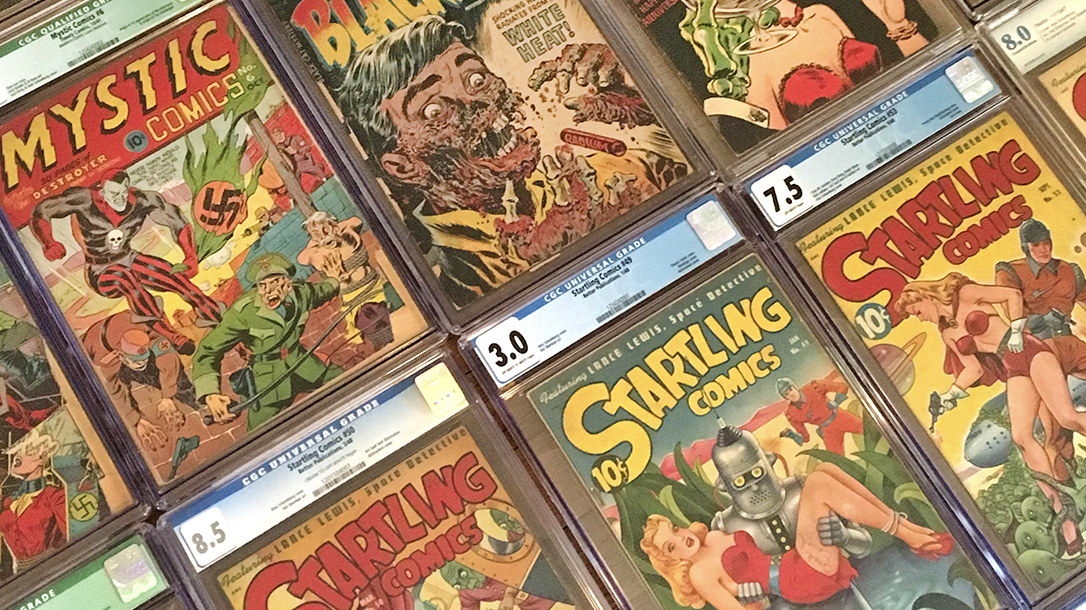A Complete Guide to the Golden Age of Comic Books

I can still hear my grandfather in his drunken, raspy voice: “Hank, you’re wasting your money on those stupid comic books.” But, honestly, I didn’t give a shit. I bought what I wanted to buy, and someone telling me I shouldn’t or couldn’t do something drove me to do it even harder. All these years later, I find myself now collecting golden age comic books, and I am glad I took my own advice.
As the years went on, I realized I had a good eye for collecting. No, I’m not a millionaire, nor do I have some kind of trust fund. I am an average, middle-class working guy who understands the hustle. I also have an eye for knowing either what’s hot or what will be. As with anything in life, take what I say with a grain of salt and err on the side of caution, but I promise you won’t be disappointed if you take a gamble.
The Golden Age of Comic Books
As you all know, the comic book world is on fire, especially the Marvel Universe, since Disney bought Marvel Entertainment. But this article is not about the “Avengers” or “Guardians of the Galaxy.” And it’s especially not about anything that was drawn on a computer. This is about the Golden Age of Comic Books, which spans from 1938-1955. Comic book collecting can be incredibly lucrative if you know what to look for, and the Golden Age of comic books is a good start.
While the Golden Age of comic books has many different genres (such as superheroes, science fiction, Westerns, romance, and pre-code horror), I am going to cover a bit of everything. I’ll give you my thoughts on what’s worth investing in and why.
The Golden Age comic book market is very hot right now. Long-term hobbyists and specialists in that field agree that there are no signs of it slowing down. In previous years, everyone was scared that no one would be around to collect the older stuff and that it would end up in a complete dead zone. Luckily, there is a big surge of younger collectors who are taking notice of and collecting Golden Age comics. From the summer of 2017 up until the present day, prices on some books have tripled on constant online auctions. The good news, though, is that everything is still within reach of the average person’s paycheck.
Condition is Key To Collecting
There are a few important side notes about buying comics, especially vintage books. You are either going to purchase raw books (non-graded books that you can read at your leisure) or graded books that have been professionally critiqued, which will tell you everything about whether they’ve been restored, trimmed, missing pages, etc. If you can’t find a comic book dealer that specializes in Golden Age books that you can trust, I highly recommend purchasing graded comic books from either a Certified Guaranty Company or a Comic Book Certification Service. These two companies are the top in their profession, and their grading scales go from .5 (poor) up to 10 (gem/mint).
Another important tip to think about when it comes to buying these vintage books is that they are usually 60-plus years old. As long as the book is intact and presents well with a cover you can be proud to show off, the grade or condition of the book doesn’t really matter. The value will be there either way. I usually recommend buying a mid-grade book that is between 2.0 and 4.0. They are affordable, and as they appreciate in value, they will still always be within a buyer’s reach.

Golden Age Comic Book Cover Art
OK, on to my favorite part. Let’s talk about what Golden Age comics to look for. I’ll start with World War II cover art first. Ever heard the expression “Don’t judge a book by its cover”? Well, delete that phrase from your brain when it comes to collecting Golden Age comic books. Ninety-five percent of picking the right Golden Age book (that will have the potential to go up in value) is based on the cover art.
Back in the 40s, most of the action books had superheroes such as The Fighting Yank, The Destroyer (Stan Lee’s first comic book creation), The Black Terror or Captain America beating up Japs and Nazis. When studying this cover art, you will notice how the artist drew these characters. The Japanese had exaggerated, slanty eyes with funny teeth, while the Germans had razor-sharp teeth and sometimes claws for hands. Even though this wouldn’t be PC by any stretch today, these books are still valuable.
The Artist
Next up, we’re looking for the right cover artist. While there are many famous artists from the 40s, when it comes to WWII action, I’m going to help you out and eliminate the guesswork.
Any covers that have been drawn by Alex Schomburg are the ones to grab. Schomburg was the quintessential artist of that era. He drew some of the most incredible World War II scenes. He also drew some groundbreaking science fiction covers that were way ahead of their time. His art is still the standard, and many present-day artists use his work for inspiration.

Pre-Code Horror Comics
Finally, we touch upon my favorite Golden Age comic book genre: Horror. These books were so gruesome that in 1954, an organization called the Comic Code Authority was put together to regulate cover art. If the cover, internal art, and story did not meet the approval of the Comic Code Authority, a comic book would have a tough time finding distribution or even being published.
That said, when looking at Golden Age horror books, the more gruesome, gross, or evil a cover is, the more desirable it will be. This genre is also known as “pre-Code horror.”
If a comic doesn’t have a small “Approved by the Comic Code Authority” label, then you are in the right place. Pre-Code horror books are hotter than hot right now. So remember kids: The more malicious, morbid, and evil a comic is, the better.
So, there you go — I’ve given you enough to get your wheels turning. Remember, building a collection should be fun and not stressful. If you are smart, strategic and know how to haggle, collecting will be a blast. Feel free to contact me on Instagram (@art_of_collecting) about any advice I have offered here. Good luck!
In this Skillset series, “The Collector,” we travel the globe in search of the most interesting acquisitions on the planet. Check out our pieces in the world’s largest pinball machine collection and one of the largest Halloween mask collections you’ll find. Also, there’s the art of collecting GI Joe toys. Here’s another piece on the Golden Age of Comic Books.


Didn’t find what you were looking for?
Read the full article here


:quality(70)/cloudfront-us-east-1.images.arcpublishing.com/archetype/VAKTJY2QR5CXVJJVDTGHXBRIZA.jpg)
:quality(70)/cloudfront-us-east-1.images.arcpublishing.com/archetype/KNKDTM6LJJCBXKKXXGTC6MBWUM.jpg)

:quality(70)/cloudfront-us-east-1.images.arcpublishing.com/archetype/JPOQUFVXQBGLBEYYJBOUTHYMIQ.jpg)

